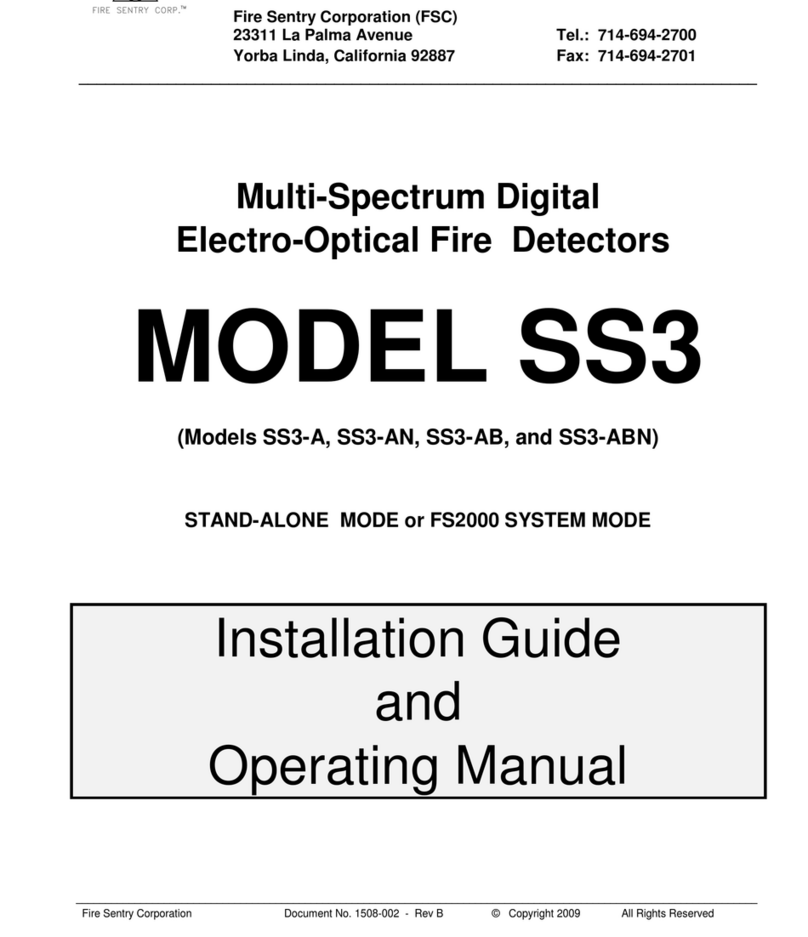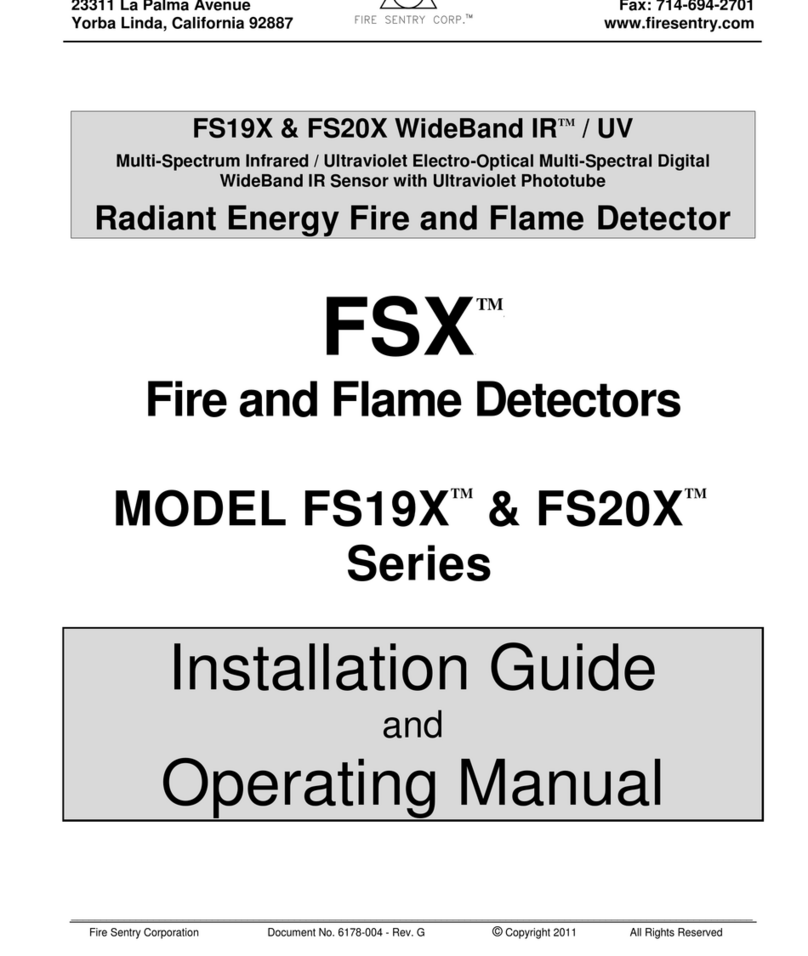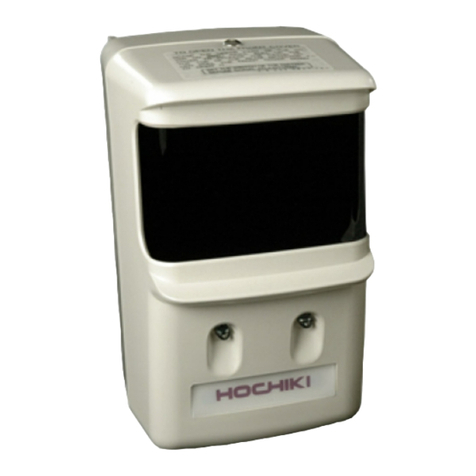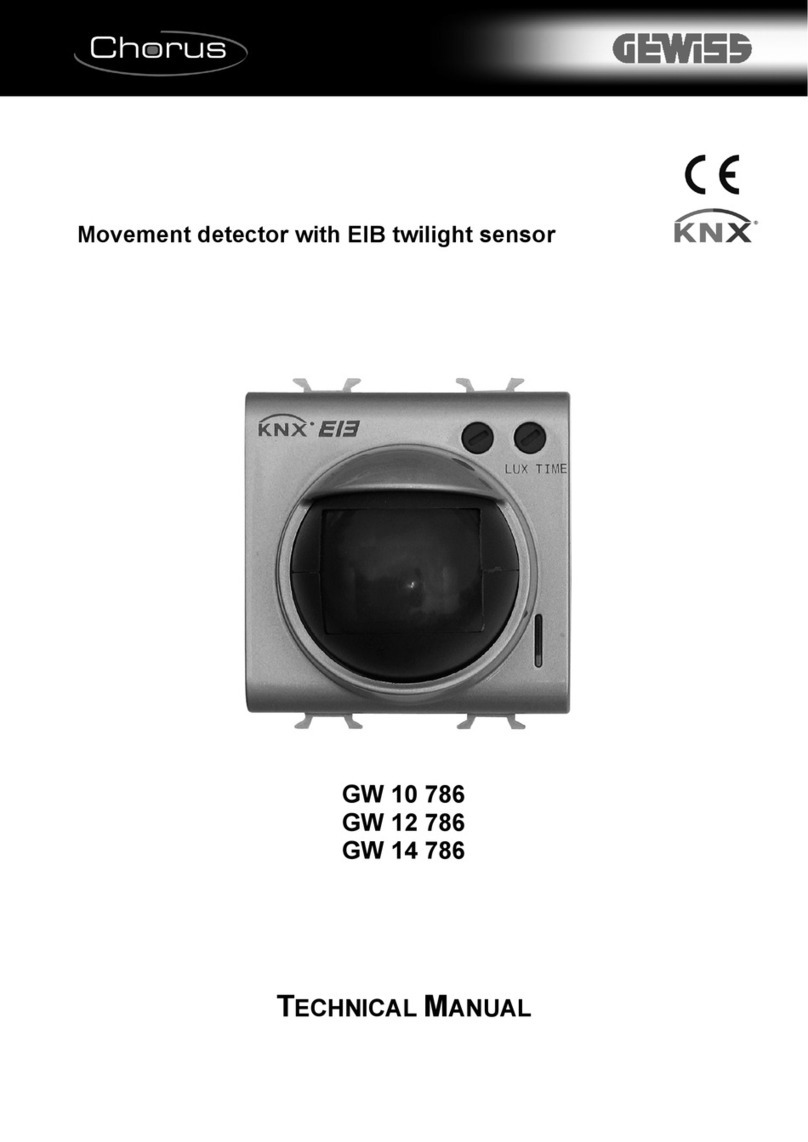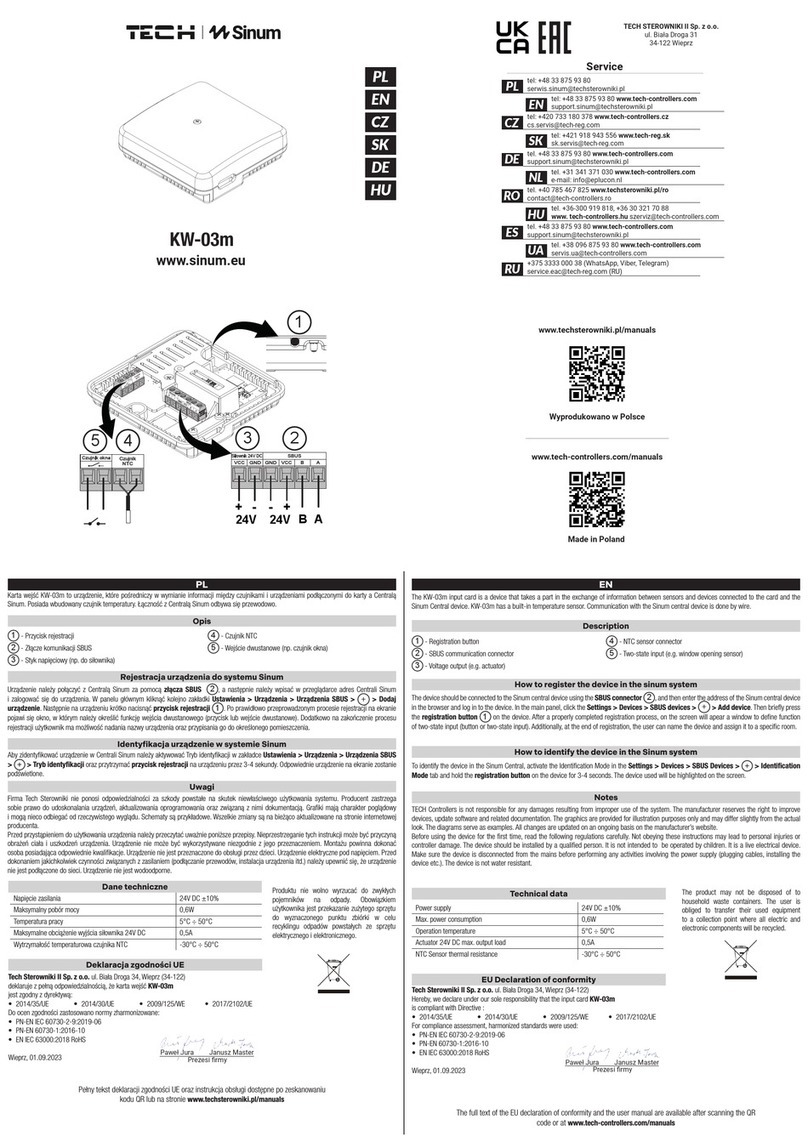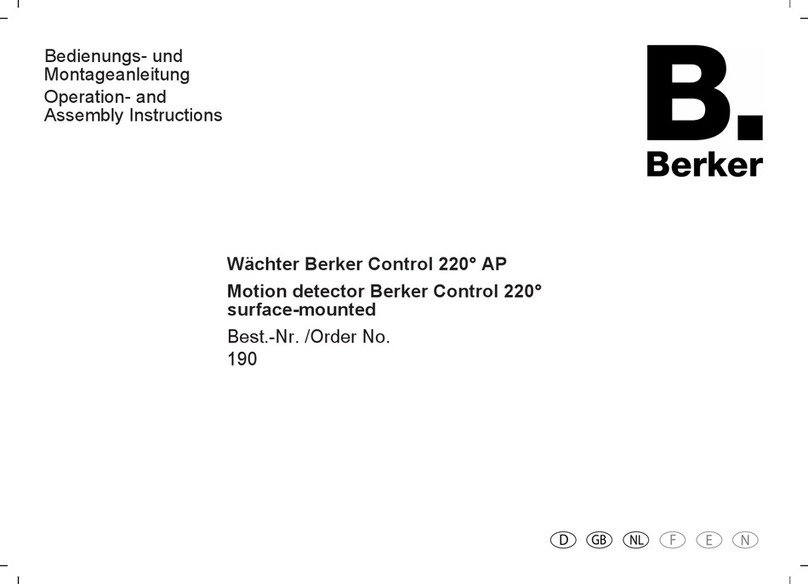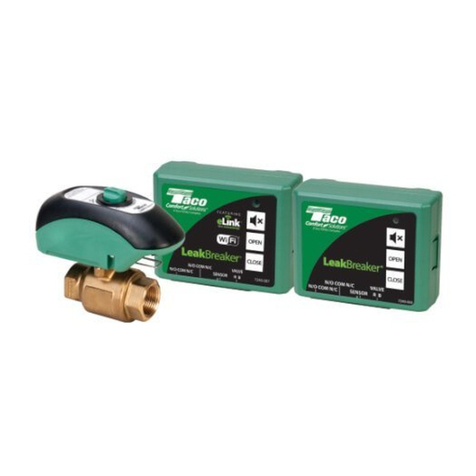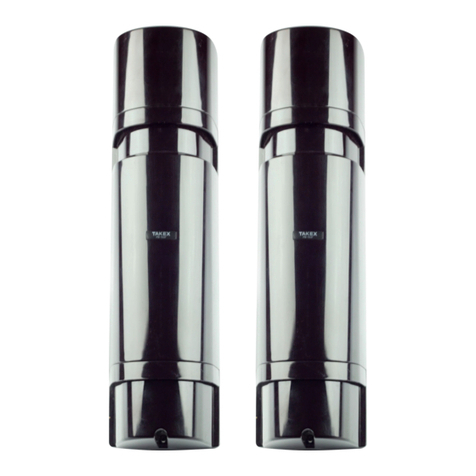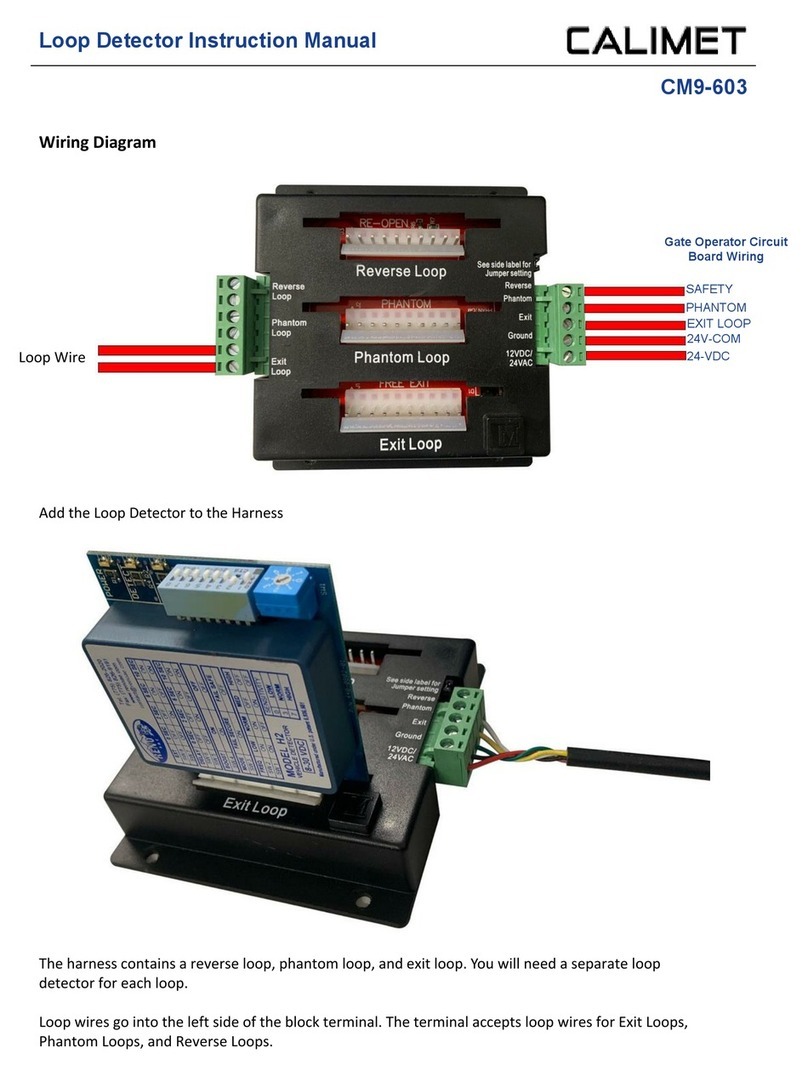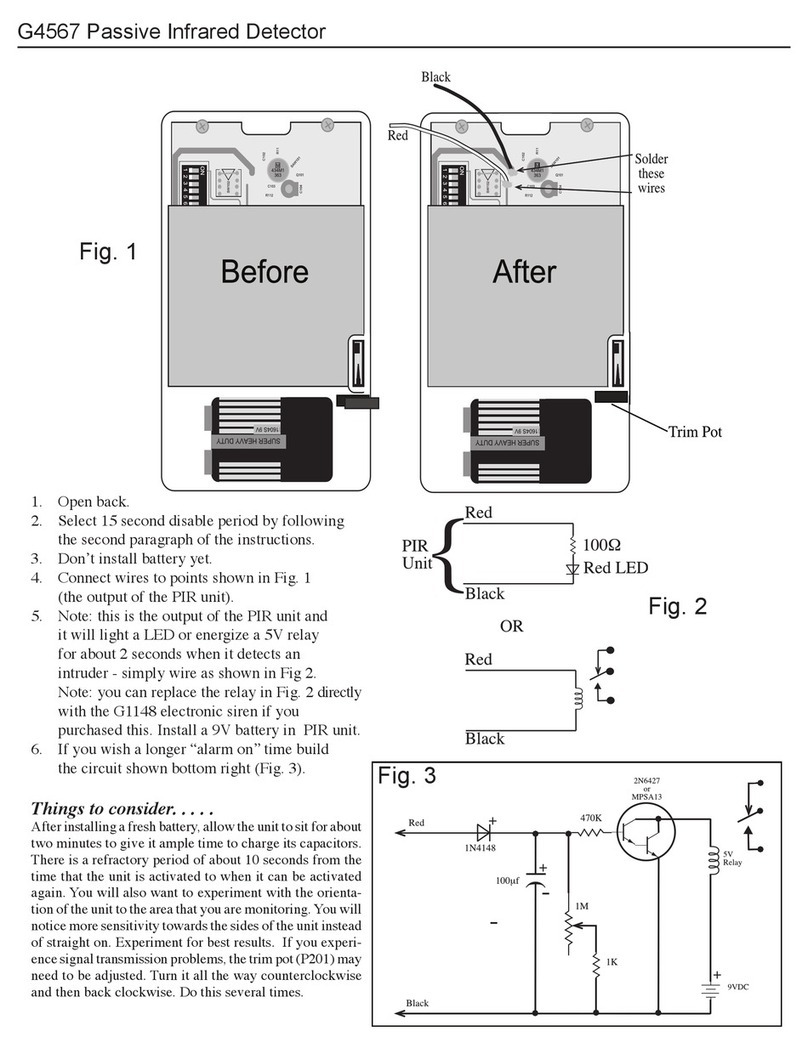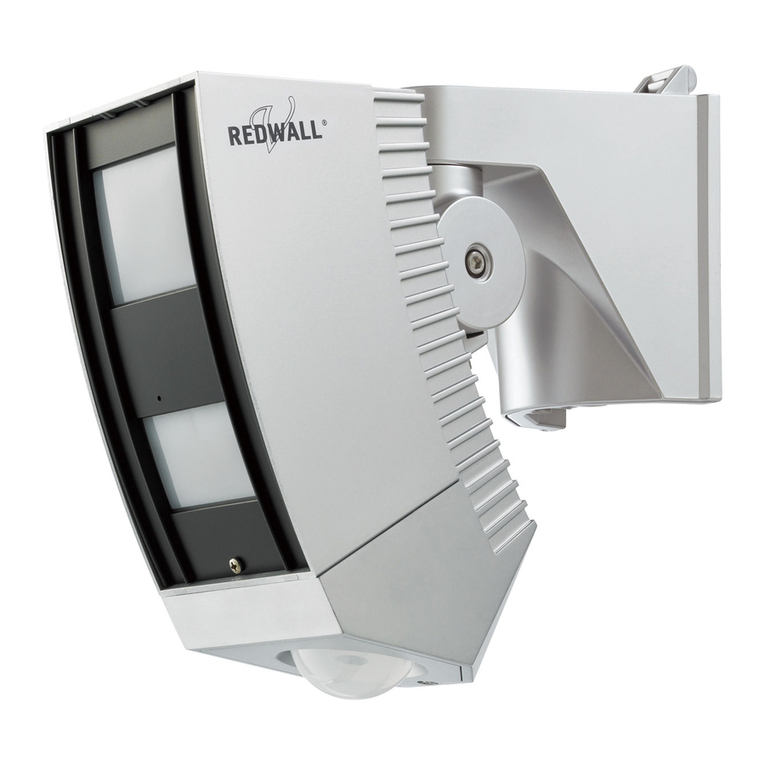Fire Sentry FSXP User manual

____________________________________________________________________________________________________________________
Fire Sentry Corporation Document No. 6178-007 - Rev. F ©Copyright 2012 All Rights Reserved
Fire Sentry Corporation
23311 La Palma Avenue
Yorba Linda, California 92887
Telephone: 714-694-2700
Fax: 714-694-2701
www.firesentry.com
FS17X WideBand IR
TM
Multi-Spectral Infrared Electro-Optical
Digital WideBand IR Sensor
Radiant Energy Fire and Flame Detector
FSX
P
TM
P
Fire and Flame Detectors
MODEL FS17X
TM
Installation Guide
and
Operating Manual

Fire Sentry Corporation Document No. 6178-007 - Rev. F ©Copyright 2012 All Rights Reserved
Fire Sentry Corporation
23311 La Palma Avenue
Yorba Linda, California 92887
Tel: (714) 694-2700
Fax: (714) 694-2701
www.firesentry.com
Read and understand this manual before
installing or operating equipment.
No part of this document may be copied or reproduced without the express
written permission of Fire Sentry Corporation.
This manual is subject to change without notice.
ACCTTL, ALERT-1, ALARM-2, ALERT-1: ALARM 2, ALERT-1: ALARM-2, ATAG, Clean
Room Sentry, COP-i, Complete Optical Path Integrity, CM1, CM1-A, DartLogic, FireLogic, Fire
Signature Analysis, FireBusI, FireBusII, FirePic, FirePicII, FirePicIII, FirePix, FirePicture, FSC,
Fire Sentry Corporation, Fire Sentry Corp., FSX, All FSX Nomenclature Variations (such as:
FS2, FS2X, FS2X, FS3, FS3X, FS3X, FS4, FS4X, FS4X, FS5, FS5X, FS5X, FS6, FS6X,
FS6X, FS7, FS7X, FS7X, FS8, FS8X, FS8X, FS9, FS9X, FS9X, FS10X, FS10X, FS11,
FS11X, FS11X, FS12, FS12X, FS12X, FS14, FS14X, FS14X, FS15, FS15X, FS15X, FS16,
FS16X, FS16X, FS17, FS17X, FS17X, FS18, FS18X, FS18X, FS19, FS19X, FS19X, FS20,
FS20X, FS20X, FS24, FS24X, FS24X, FS24XN, FS24XN, FS26, FS26X, FS26X, FS26XN,
FS26XN, FS7-2173-2RP, FS System 7, FS System 10, FS7-2173, FS7-2173-RP, FS2000, FS
System 2000, High Speed Flame & Surveillance Detector, Multi-Spectrum QuadBand Triple
IR, Multi-Spectrum TriBand, Multi-Spectrum Tri-Band, Near Band Infrared, Near Band IR,
NearBand IR, QuadBand IR, Room Sentry, RS, RS2, SM2, SM3, SS, SS2, SS2X, SS2-A,
SS3, SS3-A, SS3X, SS4, SS4-A, SS4X, SnapShot, SLR-BIT, SuperBus, SuperSentry, System
2000, Tri-Mode Plot, QuadBand Triple IR Plus, TriBand, Tri-Band, “FS & FSC triangle logo’s”,
WBIR, Wide Band Infrared, WideBand IR, Wide Band IR
are Trademarks of Fire Sentry Corporation, Yorba Linda, California.
©Copyright 1998 - 2012 by Fire Sentry Corporation

Model FS17X
™
Fire and Flame Detector
INSTALLATION GUIDE and OPERATING MANUAL
Fire Sentry Corporation Document No. 6178-007 - Rev. F © Copyright 2012 All Rights Reserved
U
TABLE OF CONTENTS
U
U
PAGE
TU
SECTION 1: INTRODUCTION .................................................................................................................................... 1
TU
1.1
UT
TU
Product Overview .............................................................................................................................. 1
1.2 Detector Technical Specifications ..................................................................................................... 2
1.2.1 Mechanical Specifications ...................................................................................................... 2
TU
1.2.2 Electrical Specifications .......................................................................................................... 2
1.2.3 Environmental Specifications ................................................................................................. 2
1.2.4 Performance Specifications ................................................................................................... 2
1.2.5 Area Classification .................................................................................................................. 2
1.3 Features & Benefits ........................................................................................................................... 3
1.4 Applications ....................................................................................................................................... 3
SECTION 2: INSTALLATION ...................................................................................................................................... 4
2.1 Mounting Instructions ......................................................................................................................... 4
2.2 Detector Connections ........................................................................................................................ 5
2.3 Installation Practices .......................................................................................................................... 8
2.4 Start-Up and Commissioning ............................................................................................................. 8
U
SECTION 3: OPERATION .......................................................................................................................................... 11
U
3.1 Principle of Operation ....................................................................................................................... 11
3.2 LED Status Indicators ....................................................................................................................... 12
3.3 Normal Operation ............................................................................................................................. 12
3.4 ALARM ............................................................................................................................................. 12
3.5 Fault................................................................................................................................................... 13
3.6 Maintenance ..................................................................................................................................... 14
U
SECTION 4: APPENDIX ............................................................................................................................................. 15
U
4.1 Warranty Information ........................................................................................................................ 15
4.2 Product Variations ............................................................................................................................ 16
4.3 Test Lamps ....................................................................................................................................... 18
4.4 Drawings ........................................................................................................................................... 19
4.4.1 Outline and Dimensions ........................................................................................................ 19
4.4.2 Wiring and Terminal Connections ......................................................................................... 20
4.4.3 Detector Label Drawings ....................................................................................................... 24
U
INDEX ......................................................................................................................................................................... 25
U

Model FS17X
™
Fire and Flame Detector
INSTALLATION GUIDE and OPERATING MANUAL
Fire Sentry Corporation Document No. 6178-007 - Rev. F © Copyright 2012 All Rights Reserved
Page 1
SECTION 1: INTRODUCTION
1.1 Product Overview
The Model FS17X™Electro-Optical Multi-Spectral Detector
senses the WideBand Infrared™ (IR) radiant energy of
blackbody particulate and molecular emissions generated by
both hydrocarbon and non-
hydrocarbon flames and fires.
Additionally, the Detector’s sensor array senses Visible Band
(VIS) and NearBand IR to further discriminate against false fire
sources. The FS17X WideBand Multi-Spectral sensor array
spans 0.4 to 3.0 microns and features a wide 120° field of
view.
The Model FS17X Multi-Spectral Fire and Flame Detector
is Factory Mutual approved for use in Class
I,
Division
2
(
Zone
2) Hazardous Locations (see Figure 1-1).
The FS17X Detector available in a polypropylene housing, is
rated IP67, dust tight, leak-proof and water tight to 1 meter.
Figure 1-1
FS17X Detector
FS17X Connections
The Model FS17X uses an eight (8) conductor Standard Cable or an optional eight (8) conductor Cable with a
Phoenix Connector for inputs and outputs. Every FS17X has the following six (6) connections:
1. +24 Vdc & DC Return
2. Fault N.C. (Normally Closed) & COM (COMmon)
3. ALARM N.O. (Normally Open)¹ & COM (COMmon)
There are 2 options for the FS17X-S Detector:
S1. Quick Response - Fireball N.O. (Normally Open)¹ & COM (COMmon) or
S2. RS-485 Data A & Data B
There are 4 options for the FS17X-G Detector:
G1. RS-485 Data A & Data B or
G2. Quick Response - Fireball N.O. (Normally Open)¹ & COM (COMmon) or
G3. Fire Verification N.O. (Normally Open)¹ & COM (COMmon) or
G2. Current sinking 4-20mA (+) & (-)
¹ Optional N.C. (Normally Closed) Relay Contacts are available.
FS17X Configurations
The Model FSX has several factory configurations to choose from:
Auxiliary: Alert (-R) or Fireball Quick Response (-S or -G) or Fire Verification (-G)
Fire Verification Time: 5 or 10 second
Relay Outputs: Latching or Non-latching
Detection Sensitivity: High or Low
Digital Communication Address: 0 to 32

Model FS17X
™
Fire and Flame Detector
INSTALLATION GUIDE and OPERATING MANUAL
Fire Sentry Corporation Document No. 6178-007 - Rev. F © Copyright 2012 All Rights Reserved
Page 2
1.2 Detector Technical Specifications
1.2.1 Mechanical Specifications
Housing Material: Polypropylene
Physical Dimensions: 4.7 in. Height
3.2 in. Width
1.7 in. Depth
Weight: 1 lbs. 4oz. With standard 20 ft cable (0.57 kg)
Enclosure Rating: IP66 / IP67
1.2.2 Electrical Specifications
Input Voltage Range: 18 Vdc to 32 Vdc
Normal Operation Current: 47 mA (nominal)
Max Fire ALARM Current: 88 mA (maximum)
Relay Contact Rating: 1 Amp @ 24 Vdc resistive
Analog Current Output: 400 Ohms Max Load (loop resistance)
0.0 to 20.0 mA (Non-Isolated, Current Sinking)
0.0 mA (<0.6 mA) = Detector Fault
2.0 mA (±0.6 mA) = Dirty Detector Window Lens
4.0 mA (±0.6 mA) = Normal, Safe (no Fault, no Fire)
20.0 mA (±0.6 mA) = Fireball or Fire ALARM
20.0 mA (±0.6 mA) = Fire ALARM or Verified Fire ALARM
Cable: Eight (8) Conductor 24 AWG or fourteen (14) Conductor 24 AWG
Maximum Cable Length = 1,400 feet
1.2.3 Environmental Specifications
Operating Temperature: +32°F to +158°F (0°C to +70°C)
Operating Humidity Range: 0 to 95% RH,
100% RH condensing for short periods of time
Storage Temperature: -13°F to +170°F (-25°C to 77°C)
1.2.4 Performance SpecificationsPPPP
Field of View: 120°Horizontal and Vertical (conical)
Detector Sensitivity:
High One (1) sq. ft. heptane fire at 30 feet (± 60°from axis)
Low One (1) sq. ft. heptane fire at 15 feet (± 60°from axis)
Speed of Response: Less than 5 seconds (typical)
Quick Response: Less than 0.5 seconds to “fireball” type fires
Spectral Sensitivity:
VIS 0.4 to 0.7 micron wavelengths
NearBand IR 0.7 to 1.1 micron wavelengths
WideBand IR 1.1 to 3.0 micron wavelengths
1.2.5 Area Classifications
Class
I
, Division 2 Class
I
, Zone 2

Model FS17X
™
Fire and Flame Detector
INSTALLATION GUIDE and OPERATING MANUAL
Fire Sentry Corporation Document No. 6178-007 - Rev. F © Copyright 2012 All Rights Reserved
Page 3
1.3 Features and Benefits
Our Patented WideBand IR Detection Technology for detecting both hydrocarbon and non-hydrocarbon
fires in industrial environmental conditions.
Uses the proven Quantum WideBand IR sensors as the highly successful Model FS7 Detectors, which
have over 25,000 successful installations in Semiconductor Cleanroom applications worldwide since 1996.
False Alarm Immunity due to the patented software signal processing algorithms and due to full WideBand
Spectrum sensor array with WideBand IR sensor wth twin Visible sensors, and twin NearBand IR sensors.
Twin highly integrated Microprocessors reduce the number of discrete components, provides larger
software algorithm programming and memory capacity, and provides redundant processor self-checking.
Lower price Detector replacement for Model FS7 applications.
Low power consumption, 24Vdc, 47mA nominal (1.13 W), 88mA max ALARM current (2.11 W).
Multiple Detector output options for a variety of industrial applications.
Up to 32 unique digital communication addresses when RS-485 communication is used.
Optional RS-485 output available (FireBus
II
protocol) for use with the FS2100X System CPX Din Rail
Panels and the FS7-130-SX Controller.
Digitally stepped 4-20mA (current sinking) output (optional).
Latching or non-latching mechanical (dry contacts) relay outputs (same reliable relays as used in the
Model FS7-2173-2RP Detectors).
Class
I
, Zone 2 polypropylene housing (sames as proven Model FS7 housing) for Clean Room,
Semiconductor Wet Bench and Wet Chemical applications.
Three Separate Bright LEDs (Red, Yellow, Blue) for quick, easy identification of ALARM, Fault and Normal
status for semiconductor clean room environments.
Our Windows® based PC Software for remote FSX diagnostics and data retrieval.
Designed, Manufactured, Tested, and Patented by Fire Sentry Corporation (30 years of proven fire / flame
detection product excellence worldwide).
1.4 Applications
The applications for the FS17X Fire and Flame Detectors include:
Clean Rooms Gas Cabinets Hydrogen Gas Cabinets
Hydrogen Plants Hydrogen Storage Semiconductor Wet Benches
Semiconductor Wet Chemicals Silane Gas Cabinets Silane Gas Manufacturing

Model FS17X
™
Fire and Flame Detector
INSTALLATION GUIDE and OPERATING MANUAL
Fire Sentry Corporation Document No. 6178-007 - Rev. F © Copyright 2012 All Rights Reserved
Page 4
SECTION 2: INSTALLATION
2.1 Mounting Instructions
Consider the following guidelines when selecting Detector location:
1. As with all flame and fire Detectors, avoid areas that contain radiant energy sources (such as radiant
heaters, high intensity lamps, flare-stacks, etc.) in close proximity to the Detector’s field of view.
2. Detectors should not be mounted outdoors. Additionally, for applications outside of an enclosed wet
bench/tool, use a minimum thirty degree (30°) downward angle with the recommended swivel mount
(Model SM-17).
3. Make sure the Detector has a clear, unobstructed view of the fire threat area. Physical obstructions
between a fire and the Detector may cause the fire to be undetected.
4. The rugged, stable, and calibrated Polypropylene Swivel Mount (SM17) is designed specifically for the
FS17X Detector housings. The mounting clip attaches to the back of the FS17X Detector. The
mounting plate, with the four (4) screw holes, is used for mounting to a solid surface. Each
adjustment increment along an axis is calibrated to 10°. For single axis adjustments, the center
section does not need to be installed.
5. Avoid mounting the Detectors in areas where temperatures exceeds the specified operating
temperature range (see Section 1.2.3).
Figure 2-1
Model SM17 Swivel Mount
There are no serviceable parts inside the Model FS17X Detector housing. If the Detector housing is opened
up or tampered with, all warranties are voided
Note: Do not attempt to modify the Model FS17X Detector as this voids all warranties.
CAUTION: Disconnect electrical power before unscrewing the Housing Lid.

Model FS17X
™
Fire and Flame Detector
INSTALLATION GUIDE and OPERATING MANUAL
Fire Sentry Corporation Document No. 6178-007 - Rev. F © Copyright 2012 All Rights Reserved
Page 5
2.2 Detector Connections
The FS17X-G and FS17X-S Detectors have eight (8) connections available with the Standard Cable. These
connections are subject to the Output Configuration of the Detector at the time the order is placed. These
Output Configurations are:
#1 RS-485 FireBus
II
II II
II
(FS17X-G & FS17X-S)
#2 Quick Response Fireball Relay (FS17X-G & FS17X-S)
#3 Fire Verification Relay (FS17X-G & FS17X-S)
#4 Current sinking 4-20mA (FS17X-G & FS17X-S)
Color Code for
Standard Cable
Output
Configuration #1
Output
Configuration #2
Output
Configuration #3
Output
Configuration #4
Red
+24 Vdc +24 Vdc +24 Vdc +24 Vdc
Black
DC Return DC Return DC Return DC Return
Green
FireBusII
Data A RS-485
Quick Response
Fireball Relay
N.O. (Normally Open)
Fire Verification Relay
N.O. (Normally Open)
Current Sinking
4-20mA (+)
White
FireBusII
Data B RS-485
Quick Response
Fireball Relay
COM (COMmon)
Fire Verification Relay
COM (COMmon)
Current Sinking
4-20mA (-)
Orange
Fire ALARM Relay
N.O. (Normally Open)
Fire ALARM Relay
N.O. (Normally Open)
Fire ALARM Relay
N.O. (Normally Open)
Fire ALARM Relay
N.O. (Normally Open)
Blue
Fire ALARM Relay
COM (COMmon)
Fire ALARM Relay
COM (COMmon)
Fire ALARM Relay
COM (COMmon)
Fire ALARM Relay
COM (COMmon)
Yellow
Fault Relay N.C.
(Normally Closed)
Fault Relay N.C.
(Normally Closed)
Fault Relay N.C.
(Normally Closed)
Fault Relay N.C.
(Normally Closed)
Brown
Fault Relay
COM (COMmon)
Fault Relay
COM (COMmon)
Fault Relay
COM (COMmon)
Fault Relay
COM (COMmon)
The following Relays have a Normally Closed (N.C.) option: Fire ALARM, Quick Response Fireball, and Fire
Verification.
1. Make sure that the external 24 Vdc electrical power is turned
U
OFF
U
before connecting the Detector.
2. Avoid wire splices. However, if wire splices are required, all splices should be soldered and properly
insulated. The use of good wiring practices will simplify installation, improve reliability and facilitate
maintenance.
CAUTION:
Follow static protection procedures while handling the connectors and the
wiring of the FS17X Detector. Use a wrist strap connected to earth ground.

Model FS17X
™
Fire and Flame Detector
INSTALLATION GUIDE and OPERATING MANUAL
Fire Sentry Corporation Document No. 6178-007 - Rev. F © Copyright 2012 All Rights Reserved
Page 6
Detector Connections (
continued
)
The FS17X-G and FS17X-S Detectors have eight (8) connections available with the Phoenix Connector.
These connections are subject to the Output Configuration of the Detector at the time the order is placed.
These Output Configurations are:
#1 RS-485 FireBus
II
II II
II
(FS17X-G & FS17X-S)
#2 Quick Response Fireball Relay (FS17X-G & FS17X-S)
#3 Fire Verification Relay (FS17X-G & FS17X-S)
#4 Current sinking 4-20mA (FS17X-G & FS17X-S)
Color Code for
Cable with Phoenix
Connector
Output
Configuration #1
Output
Configuration #2
Output
Configuration #3
Output
Configuration #4
Brown
+24 Vdc +24 Vdc +24 Vdc +24 Vdc
Blue
DC Return DC Return DC Return DC Return
Gray
FireBusII
Data A RS-485
Quick Response
Fireball Relay
N.O. (Normally Open)
Fire Verification Relay
N.O. (Normally Open)
Current Sinking
4-20mA (+)
Violet
FireBusII
Data B RS-485
Quick Response
Fireball Relay
COM (COMmon)
Fire Verification Relay
COM (COMmon)
Current Sinking
4-20mA (-)
Red
Fire ALARM Relay
N.O. (Normally Open)
Fire ALARM Relay
N.O. (Normally Open)
Fire ALARM Relay
N.O. (Normally Open)
Fire ALARM Relay
N.O. (Normally Open)
Yellow
Fire ALARM Relay
COM (COMmon)
Fire ALARM Relay
COM (COMmon)
Fire ALARM Relay
COM (COMmon)
Fire ALARM Relay
COM (COMmon)
Green
Fault Relay N.C.
(Normally Closed)
Fault Relay N.C.
(Normally Closed)
Fault Relay N.C.
(Normally Closed)
Fault Relay N.C.
(Normally Closed)
White
Fault Relay
COM (COMmon)
Fault Relay
COM (COMmon)
Fault Relay
COM (COMmon)
Fault Relay
COM (COMmon)
The following Relays have a Normally Closed (N.C.) option: Fire ALARM, Quick Response Fireball, and Fire
Verification.
1. Make sure that the external 24 Vdc electrical power is turned
U
OFF
U
before connecting the Detector.
2. Avoid wire splices. However, if wire splices are required, all splices should be soldered and properly
insulated. The use of good wiring practices will simplify installation, improve reliability and facilitate
maintenance.
CAUTION:
Follow static protection procedures while handling the connectors and the
wiring of the FS17X Detector. Use a wrist strap connected to earth ground.

Model FS17X
™
Fire and Flame Detector
INSTALLATION GUIDE and OPERATING MANUAL
Fire Sentry Corporation Document No. 6178-007 - Rev. F © Copyright 2012 All Rights Reserved
Page 7
Detector Connections (
continued
)
The The FS17X-R Detector has fourteen (14) connections available. These connections are:
Color Code Description
Red 24 VDC (+) Supply
Black 24 VDC (-) Return
Green FireBusII RS-485 Digital Data A Signal
White FireBusII RS-485 Digital Data B Signal
Gray Fault Relay Terminal A, Contact to B during Normal Operation
Purple Fault Relay Terminal B, Contact to A during Normal Operation
Brown Fire ALARM Relay Terminal A
Blue Fire ALARM Relay Terminal B
Brown / White Fire ALARM Relay Terminal A loop-through
Blue / White Fire ALARM Relay Terminal B loop-through
Yellow Fire ALERT Relay Terminal A
Orange Fire ALERT Relay Terminal B
Yellow / Black Fire ALERT Relay Terminal A loop-through
Orange / Black
Fire ALERT Relay Terminal B loop-through
1. Make sure that the external 24 Vdc electrical power is turned
U
OFF
U
before connecting the Detector.
2. Avoid wire splices. However, if wire splices are required, all splices should be soldered and properly
insulated. The use of good wiring practices will simplify installation, improve reliability and facilitate
maintenance.
CAUTION:
Follow static protection procedures while handling the connectors and the
wiring of the FS17X Detector. Use a wrist strap connected to earth ground.

Model FS17X
™
Fire and Flame Detector
INSTALLATION GUIDE and OPERATING MANUAL
Fire Sentry Corporation Document No. 6178-007 - Rev. F © Copyright 2012 All Rights Reserved
Page 8
2.3 Installation Practices
For installations in a Hazardous Classified Area, consult the National Electric Code Handbook, Articles 500
through 517 for the proper installation practices. For locations outside of the United States, observe local
and/or regional regulations.
BEFORE APPLYING 24 Vdc ELECTRICAL POWER TO THE DETECTOR, MAKE SURE
U
:
1. Wire connections are correct (Section 2.2). Each wire must be stripped properly to the correct length,
loose wire strands must be removed and each wire must be securely and firmly screwed clockwise in
the connector.
2. If using the Teflon Sleeve, ensure a proper sleeve seal at the bulkhead, (appropriate for the area
classification), has been installed and
U
all measures to prevent moisture from entering the
Detector housing have been taken
U
.
3. The FS17X Detector is securely mounted and has an unobstructed view of the area of coverage
(Section 2.1).
4. The FS17X Detector window is unobstructed and clean.
The FS17X Detector is now ready for Power-Up. On Power-Up, the Fault Relay will change state and the
three front red, blue, and yellow LED’s will flash in a clockwise circular motion signifying the
microprocessors are successfully checking out the sensors and electronics in the Detector Module.
2.4 Start-Up and Commissioning
ATTENTION: FSX Power-Up – After the application of 24 Vdc electrical power or after resetting the FS17X
Detector, a Power-On Self-Test (POST) will be performed automatically. During this time
(approximately 10 seconds) the detector will sequence in a clockwise circular motion through the its
LED’s several times. Wait a mimimum of thirty (30) seconds after the POST is completed to allow
the Detector’s sensors to normalize to the spectral background conditions. Count four (4) Blue LED
flashes to be sure the minmum amount of time has passed before testing the Detector’s response
with a test lamp (TL-2055X or TL-1055X) or a test fire.
FSX Detector Testing - As with any intelligent flame and fire Detector, please wait a minimum of
thirty (30) seconds between tests (i.e., FSX test lamp, butane lighter, or test fires) to allow the
Detector’s sensors to normalize to the spectral background conditions.
During Start-Up and Commissioning, DISABLE all outputs from the Detector to any control panels or control
devices. After the Detector(s) is powered, as with all flame and fire Detectors, conduct an external Detector
test “end to end”. Using our external FSX hand-held test lamp ensures that the FS17X Detector has a clear
unobstructed view of the threat area and the Detector is aimed properly at the fire threat area.

Model FS17X
™
Fire and Flame Detector
INSTALLATION GUIDE and OPERATING MANUAL
Fire Sentry Corporation Document No. 6178-007 - Rev. F © Copyright 2012 All Rights Reserved
Page 9
Start-Up and Commissioning (
continued
)
Note: As with
U
all
U
optical fire and flame Detectors, perform a fully functional "end to end" test of the
Detector since the optical path to the fire threat may be obstructed or the detector’s mount
may be damaged (see Section 3.6).
Note: In order to test the full functionality and operational readiness of
U
any
U
fire or flame Detector
"end to end", without starting a real fire (which is not permitted in hazardous areas), it is
necessary to test fire and flame detector(s) with an external test lamp.
Using a test lamp is the
U
only
U
non-hazardous and safe method to test any flame or fire
Detector’s sensors, internal electronics and its alarm activation software, viewing window lens
cleanliness, terminal wiring integrity, actual relay activation, and the proper functionality of
any other outputs that are used. Also, since most Detectors are installed in a fire protection
system, this is the only method to test the complete fire protection system, ensuring all the
system wiring and cabling and system control panel(s) are properly installed.
Additionally, using an external test lamp eliminates the following Detector conditions:
1. The fire or flame Detector(s)' viewing lens being covered up (such as paint, paint overspray,
paint masking material, plastic coverings left by cleaning persons, hanging garments, etc.),
2. Improperly positioned and orientated Detector (or defective or loose mount) for coverage of
the threat area,
3. Partial or full blockage of the Detector's line of sight by one or more objects (i.e., recently
installed air ducts or pipes, storage boxes, vehicles, etc.) such that the fire threat area is
not fully protected. Since all optical fire and flame Detectors are line-of-sight devices, they
must be properly positioned and oriented with an unobstructed view of the fire threat area
so that they can detect fires.
To test the full functionality of a FSX Detector, use either the Model TL1055X or TL2055X Test
Lamp in the manner prescribed in this Instruction Manual.
The TL-1055X and the TL-2055X are the ONLY Test Lamps that will activate the FSX Detectors.
Additionally, do not use these Test Lamps to activate other Fire Sentry Detectors such as the
Models SS2 or SS4 (nor any other conventional fire and flame detectors). Do not use other
Fire Sentry Test Lamps to test the FSX Detectors.

Model FS17X
™
Fire and Flame Detector
INSTALLATION GUIDE and OPERATING MANUAL
Fire Sentry Corporation Document No. 6178-007 - Rev. F © Copyright 2012 All Rights Reserved
Page 10
Start-Up and Commissioning (
continued
)
Figure 2-8
TL-1055X Hand Held Test Lamp (NEMA 1)
Figure 2-9
TL-2055X Hand Held Test Lamp for Hazardous Areas
FM, cFM, FM-ATEX Approved
Remember to disable the Detector outputs, as a full functional test includes activating the alarm outputs. A
FSX Fire Sentry Test Lamp must be used for this test (Section 4.3). Point the Test Lamp directly at the front
of the Detector (on axis as much as possible, within a distance of 1 to 25 feet). Activate the Test Lamp by
pressing and holding its pushbutton. While watching the red ALARM LED on the face of the Detector, slowly
move the Test Lamp’s boresight to ensure the Detector receives its full intensity. (
U
NOTE: Practicing this
technique may help to optimize testing of the FSX Detectors
U
). (Sections 3.6 and 4.3). The Detector’s
ALARM LED will illuminate, usually within three (3) to ten (10) seconds. Also, the ALARM Relay outputs will
activate and the 4-20 mA analog output will increase to 20 mA (±0.6 mA).
If the Detector does not respond within ten (10) seconds, do the following:
1. Wait thirty (30) seconds before performing another test.
2. Check the Distance: verify that the testing distance is between one (1) and fifteen (15) feet from
the FSX Detector(s).
3. Check Aiming Accuracy: verify that the proper testing technique (as described above) is followed.
4. Make sure the Test Lamp is either a Model TL-2055X or TL1055X Test Lamp.

Model FS17X
™
Fire and Flame Detector
INSTALLATION GUIDE and OPERATING MANUAL
Fire Sentry Corporation Document No. 6178-007 - Rev. F © Copyright 2012 All Rights Reserved
Page 11
SECTION 3: OPERATION
3.1 Principle of Operation
Fire Sentry Corporation’s (line of Multi-Spectral and MultiBand™Infrared Fire and Flame Detectors are
sophisticated, state of the art, electro-optical digital radiant energy Detectors that sense the wideband radiant
energy emitted by fire’s combustion processes that include flames’ molecular emissions and hot particulate
blackbody emissions. Radiant Energy Fire Detectors respond much faster to flames and fires at a longer
distance than other types of conventional photoelectric and ionization smoke and heat detectors because a
fire’s emitted radiant energy travels at the speed of light. Fast response is critical for detecting flaming fires in
time to successfully activate suppression or activate other fire responses such as closing fire doors. Seconds
can make the difference between suppressing a small fire with little or no damage or having a disastrous fire
that overwhelms a suppression system.
Infrared (IR) consists of spectral wavelengths longer than the color Red. For the FS17X Detector, the IR
spectral range for fire detection, which a large portion of the spectrum is invisible to the human eye, is from
approximately 400 to 3000 nanometers (0.4 to 3.0 microns). Fire Sentry Corporation’s Detectors sense and
measure the radiant energy generated by a fire at the speed of light using high speed infrared quantum
sensors for its IR detectors.
Fire Sentry Corporation’s patented FSX Fire Detectors also use two additional spectral regions, the Visible
Band, that spans from about 400 to 700 nanometers (0.4 to 0.7 microns) and the NearBand IR that span from
about 0.7 to 1.1 microns. The Visible Band and NearBand IR are used primarily to further discriminate against
non-fire false alarm sources.
As with all Fire Sentry Corporation Detectors, the Model FS17X Detector senses radiant energy generated by
both hydrocarbon and non-hydrocarbon fires. Built-in microprocessors use sophisticated Digital Signal
Processing (DSP) to accurately distinguish radiant energy from a real fire and a false alarm source(s). Fire
Sentry Corporation has developed and refined these complex proprietary and patented WideBand IR
algorithms since 1981. These patented algorithms perform real-time DSP, and precisely analyze the signals
in high-resolution frequency and time domains. This decision making process involves thousands of real-time
calculations every second. Fire Sentry Corporation’s FSX Detectors use solid-state high speed quantum
sensors (not heat sensors such as pyroelectric or thermopile) that all respond to the fire’s radiant energy
emissions. The quantum sensors convert the rate of photonic energy directly into analog electrical signals.
These analog signals are converted to high resolution digital values for real-time microprocessor analysis.
The Detector microprocessors incorporate random access memory (RAM), read-only memory (ROM), and
non-volatile flash memory. When the microprocessors determine that a real fire has been detected, the pre-
alarm digital sensor data (FirePic™) and the event information are recorded in flash memory. Depending on
the configuration, other actions may include activating one or more status LEDs, relays, a current loop and
sending digital data via the RS-485 FireBus
II
™. If the microprocessors determine, based on internal testing
and “through-the-lens” testing, that the Detector is not operating correctly, it records the Fault data in flash
memory and activates the Fault outputs and the yellow status LED. The digital data in the Detector can be
accessed with a PC for later analysis and record keeping using Fire Sentry’s Windows
®
based PC software
and the FSIM USB Interface Unit.

Model FS17X
™
Fire and Flame Detector
INSTALLATION GUIDE and OPERATING MANUAL
Fire Sentry Corporation Document No. 6178-007 - Rev. F © Copyright 2012 All Rights Reserved
Page 12
3.2 LED Status Indicators
As with all FSX Detectors, the Model FS17X Detector uses three (3) separate, bright LED’s (rather than one
tri-colored LED that can be difficult to recognize the different colors outdoors or in a brightly lit area) to indicate
the Detector’s status.
The Blue LED blinks (flashes) once every ten (10) seconds to indicate a Normal, safe operational
condition (i.e. no Faults and no Alarms). The Blue LED is OFF when no external 24 Vdc input power is
applied to the Detector.
The Red LED turns ON when the FS17X goes into ALARM. The Red LED flashes when the FS17X-R
version goes into ALERT.
The Yellow LED blinks (flashes) when the window lens is dirty. For all other Fault conditions, the
Yellow LED will turn ON solidly (see Section 3.5).
3.3 Normal Operation
In Normal Operation, the bright Blue LED blinks (flashes) every 10 seconds. See Figure 3-1 for the location
of the Blue LED. Normal Operation is defined as the Detector with 24 Vdc applied and no ALARM or Fault
conditions are present.
Flashes
LED
Status
1 Blue Normal Operation (No Faults and No Alarms)
2 Blue Normal Operation and Communication*
*The Blue LED will be OFF when there is a Detector Fault
Figure 3-1
Blue LED Location
The number of Blue LED flashes immediately following the
power-up sequence identifies the type of FS17X:
Two (2) Flashes for the
FS17X-S
(Semiconductor Detector)
Four (4) Flashes for the
FS17X-G
(General Purpose Detector)
Six (6) Flashes for the
FS17X-R
(Radiant Energy Detector)
3.4 ALARM
When an ALARM occurs, the Red LED will turn ON, (factory setting with the Auxiliary relay set to “0”
seconds). See Figure 3-2 for the location of the Red LED.
The Detector has the following ALERT, ALARM or Fire
Verification outputs:
ALERT Relay activation
ALARM Relay activation
Fire Verification Relay activation
1
4-20 mA
1
(sink 20 mA) ALARM Output
4-20 mA
1
(sink 20 mA) Fire Verifification Output
1
RS-485 FireBus
II
ALERT Notification
1
RS-485 FireBus
II
ALARM Notification
1
Figure 3-2
Red LED Location 1 Only one active output from this group

Model FS17X
™
Fire and Flame Detector
INSTALLATION GUIDE and OPERATING MANUAL
Fire Sentry Corporation Document No. 6178-007 - Rev. F © Copyright 2012 All Rights Reserved
Page 13
3.5 Fault
When a Fault (Trouble) occurs, the Yellow LED will illuminate. See Figure 3-3 for the location of the Yellow
LED.
The Detector has the following Fault outputs:
Fault Relay activation
4-20 mA (sink) Output
2
2 mA (Self-Test/Lens Obscuration Fault)
0 mA (All Other Faults)
RS-485 FireBus
II
Fault Notification
2
Figure 3-3
Yellow LED Location 2 Only one active Fault output from this group
The FS17X has the following Fault (Trouble) outputs:
Flashes
LED Fault Cause Remedy
3
Yellow Self Test Fault Sensor response is out of range.
Contact Fire Sentry
Corporation to speak
with a Technical
Representative.
4
Yellow Relay Coil Fault or Leak
Detection Fault
One or more Relay Coils has an
open or a short; OR Moisture is
inside of the Detector Housing.
Contact Fire Sentry
Corporation to speak
with a Technical
Representative.
5
Yellow High or Low Temperature
Fault
Less than -40°C or
Greater than +60°C (Zone 2) or
Greater than +85°C (Zone 1)
Contact Fire Sentry
Corporation to speak
with a Technical
Representative.
6
Yellow High or Low Input Voltage
Fault
Less than +18 Vdc or
Greater than +32 Vdc
Verify the DC Voltage
at the FS17X
Detector
is between 18 Vdc
and 32 Vdc. DC
voltage, not AC.
Solid
ON
Yellow Major Internal Fault
Microprocessor Fault
Communication Fault
Internal Electronic Self-Test Fault
Contact Fire Sentry
Corporation to speak
with a Technical
Representative.
The Blue LED will be OFF during Detector Faults.
In addition to the Remedies listed above, cycle (re-apply) primary input power to the Detector. If any of the
Faults listed above continues after taking the appropriate remedy, contact a Technical Representative at Fire
Sentry Corporation. It may be necessary to obtain a Return Merchandise Authorization Number (RMA #) and
return the Detector to the Factory.

Model FS17X
™
Fire and Flame Detector
INSTALLATION GUIDE and OPERATING MANUAL
Fire Sentry Corporation Document No. 6178-007 - Rev. F © Copyright 2012 All Rights Reserved
Page 14
3.6 Maintenance
After the FS17X Detector is installed and commissioned, virtually no maintenance required in a clean room
environment. However, a complete “end-to-end” test of the entire fire detection system should be performed
monthly or more frequently, depending on the application. Additionally, semi-annual or quarterly testing should
be performed, using the correct Fire Sentry Test Lamp, to ensure the integrity of the entire fire protection
system. (see Note in Section 2.4 and Section 4.3)
Clean the FS17X Detector window:
Each time the Detector is taken out of or put back into to service.
Detector window is dirty or contaminated.
Detector does not respond to an end-to-end test with the Fire Sentry Corporation hand-held portable
Test Lamp (TL-1055X or TL-2055X).
Each time the Detector has been disassembled for wiring or replacement.
Use a blast of clean air or an oil-free cloth to clean the Detector window. Occassionally, the use of a solvent,
such as alcohol is acceptable. No disassembly of the Detector is required.

Model FS17X
™
Fire and Flame Detector
INSTALLATION GUIDE and OPERATING MANUAL
Fire Sentry Corporation Document No. 6178-007 - Rev. F © Copyright 2012 All Rights Reserved
Page 15
SECTION 4: APPENDIX
4.1 Warranty Information
Fire Sentry Corporation warrants the FSX Detectors against defects in material and workmanship under
normal use and service for a period of three (3) years from the date of shipment as described herein.
Equipment manufactured by Fire Sentry Corporation is designed for use in Fire Detection applications in
industrial environments. Fire Sentry Corporation, at its option, will repair or replace, at no charge, such
products found to be defective during the warranty period provided that they are returned in accordance with
the terms of this warranty. Replaced parts or boards are warranted for the balance of the original applicable
warranty period. All Replaced parts of Products shall become the property of Fire Sentry Corporation. This
express limited warranty is extended by Fire Sentry Corporation to the original purchaser only and is not
assignable or transferable to any other party. This is the complete warranty for the Products manufactured by
Fire Sentry Corporation. Fire Sentry Corporation assumes no obligations or liability for additions or
modifications to this warranty unless made in writing and signed by an officer of Fire Sentry Corporation. Fire
Sentry Corporation does not warrant the installation, maintenance or service of its Products. Fire Sentry
Corporation is not responsible in any way for ancillary equipment not furnished by Fire Sentry Corporation,
which is attached to or used in connection with its Product(s), or for operation of the Product(s) with ancillary
equipment and all such equipment is expressly excluded from this warranty.
This Warranty is given in lieu of all other warranties, express or implied, including without limitation, implied
warranties of merchantability and fitness for a particular purpose. In no event shall Fire Sentry Corporation be
liable for damages in excess of the purchase price of the Product(s), for any loss of use, loss of time,
inconvenience, commercial loss, lost profits or savings or other incidental, special or consequential damages
arising out of or in connection with the use or inability to use such Product.
THIS WARRANTY DOES NOT COVER:
1. Defects or damage resulting from use of the Product(s) in other than the normal and customary
manner.
2. Defects or damage from misuse, misapplication, accident, or neglect.
3. Defects or damage from improper testing, operation, maintenance, installation, alteration,
modification or adjustment.
4. Product(s) subject to unauthorized Product modifications, disassemblies or repairs (including,
without limitation, the addition to the product of non-Fire Sentry Corporation supplied equipment)
which adversely affect performance of the Product(s) or which interfere with Fire Sentry’s normal
warranty inspection and testing of the Product(s) to verify any warranty claim.
5. Product(s) that have had the serial number removed or made illegible.
6. Freight cost to the repair facility.
7. A Product which due to illegal or unauthorized alteration of the software/firmware in the Product,
does not function in accordance with Fire Sentry Corporation specifications.
8. Scratches or other cosmetic damage to Product surfaces that do not affect the operation of the
Product.
9. Normal and customary wear and tear.
10. Product(s) which are not used in industrial applications.
Laws in the United States and other countries preserve for Fire Sentry Corporation certain exclusive rights for
copyrighted Fire Sentry Corporation software/firmware, such as the exclusive rights to reproduce in copies and
distribute copies of such Fire Sentry Corporation software/firmware. Fire Sentry Corporation
software/firmware may be used only in the Product(s) in which the software/firmware was originally embodied
and such software/firmware in such Product(s) may not be replaced, copied, distributed, modified in any way,
or used to produce any derivative thereof. No other use including, without limitation, alteration, modification,
reproduction, distribution, or reverse engineering of such Fire Sentry Corporation software/firmware or
exercise or rights in such Fire Sentry Corporation software/firmware is permitted. No license is granted by
implication, estoppel or otherwise under Fire Sentry Corporation patent rights or copyrights.

Model FS17X
™
Fire and Flame Detector
INSTALLATION GUIDE and OPERATING MANUAL
Fire Sentry Corporation Document No. 6178-007 - Rev. F © Copyright 2012 All Rights Reserved
Page 16
4.2 Product Variations
All options for the FS17X must be specified on the customer’s purchase order. Here is a list of current
ordering options for the Model FS17X™:
Model - # # # # # # #
Tubing Length
X No Tubing
A 41” (Standard)
Model # B 60 “
FS17X
Eight Conductor Cable Length
1 3 meters (10 feet)
2 6 meters (20 feet) (Standard)
3 12 meters (40 feet)
4 18 meters (60 feet)
5 24 meters (80 feet)
Connection Type
C Integral Cable, 8 conductor (Free End)
Z Integral Cable, 8 conductor (Kalrez O-Ring)
P Phoenix 8-Pin Connector
Relay Contact – Fault N.C., Normally Energized, Non-Latching
1 Fire Relays N.O., Normally De-Energized, Non-Latching
2 Fire Relays N.O., Normally De-Energized, Latching
3 Fire Relays N.C., Normally De-Energized, Non-Latching
4 Fire Relays N.C., Normally De-Energized, Latching
Output Options (FS17X-S / FS17X-G)
A Fault, ALARM, Aux Relays w/ Fireball (FS17X-S)
B Fault & ALARM Relays and RS-485 (FS17X-S)
1 Fault & ALARM Relays and RS-485 (FS17X-G)
2 Fault, ALARM, Aux Relays w/ 5 second Verify (FS17X-G)
3 Fault, ALARM, Aux Relays w/ 10 second Verify (FS17X-G)
4 Fault & ALARM Relays and 4-20mA (FS17X-G)
6 Fault, ALARM, Aux Relays w/ Fireball (FS17X-G)
Detector Sensitivity
H High Sensitivity (Standard)
L Low Sensitivity
Detector Type - Application
G General Purpose
S Semiconductor

Model FS17X
™
Fire and Flame Detector
INSTALLATION GUIDE and OPERATING MANUAL
Fire Sentry Corporation Document No. 6178-007 - Rev. F © Copyright 2012 All Rights Reserved
Page 17
Product Variations (
continued
)
Model - A B C D E - F G H
H Tubing Length
A 41" (Standard)
Model # B 60"
FS17X
G 14 Conductor Cable Length
1 3 meters (10 feet)
2 6 meters (20 feet) (Standard)
3 12 meters (40 feet)
4 18 meters (60 feet)
5 24 meters (80 feet)
F O-Ring
K Kalrez O-Ring
V Viton O-Ring (Standard)
E Relay Mode
N Non-Latching (Standard)
D Relay Contacts
Alert & Alarm Normally Open and Normally De-Energized,
1 Fault Normally Closed and Normally Energized (Standard)
C Outputs
A Fault, Alert & Alarm Relays with FireBusII (Standard)
B Detector Sensitivity
H High Sensitivity (Standard)
A Detector Type - Application
R Radiant Energy (Standard)
This manual suits for next models
1
Table of contents
Other Fire Sentry Security Sensor manuals
Popular Security Sensor manuals by other brands
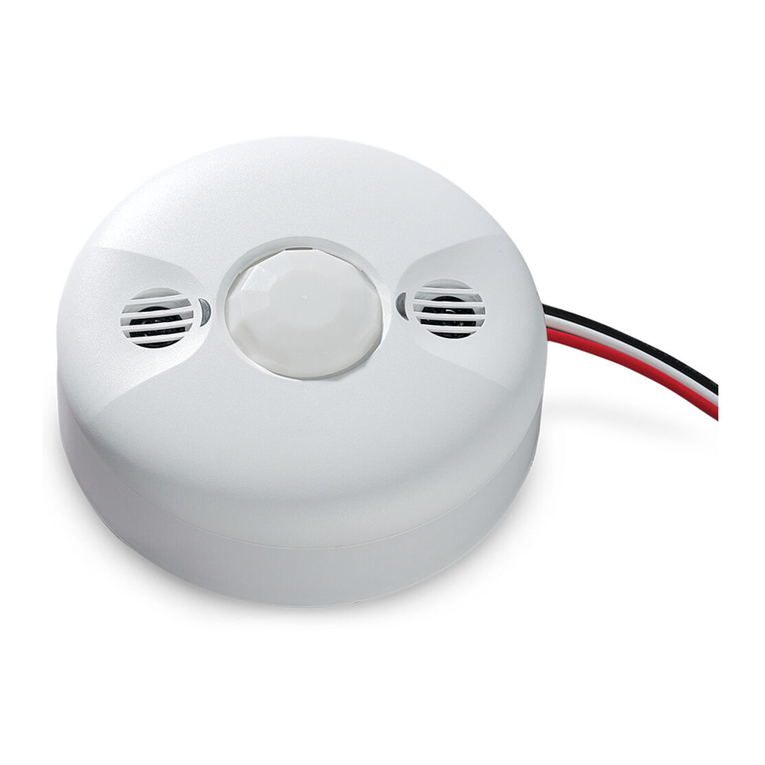
Intermatic
Intermatic IOS-CMP-DT-U Installation and configuration instructions

steute
steute Ex HS Si 4-3G/D Mounting and wiring instructions
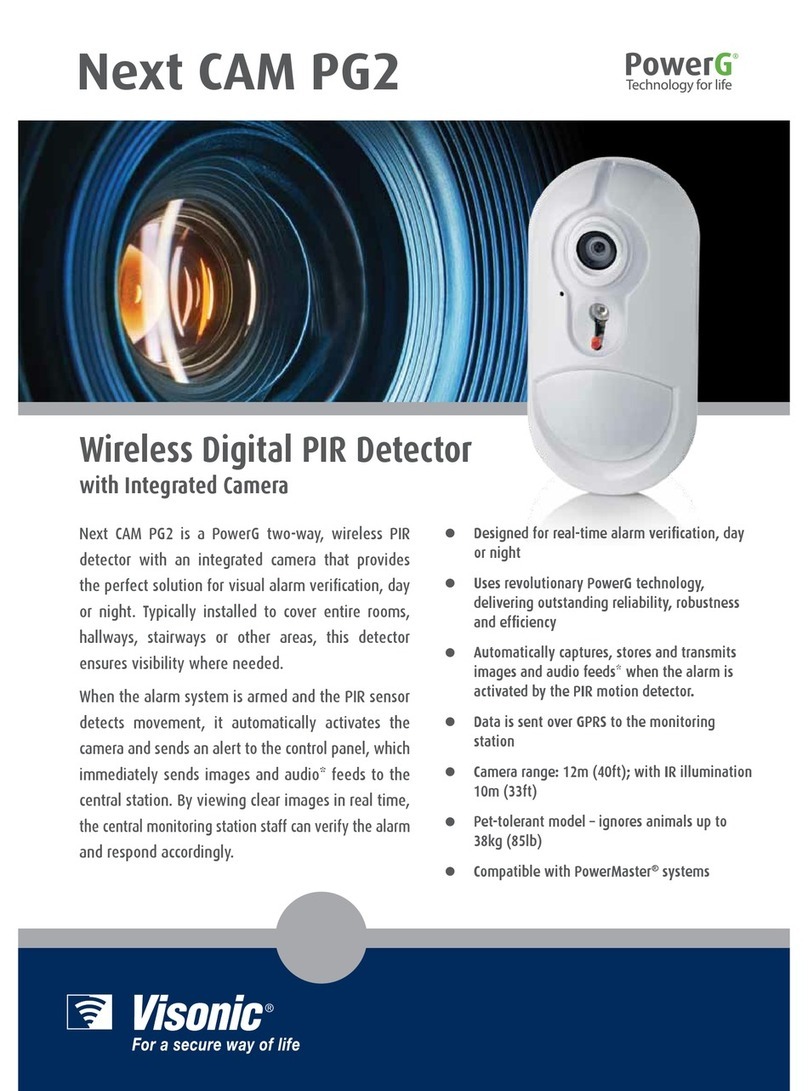
Visonic
Visonic NEXT CAM PG2 datasheet
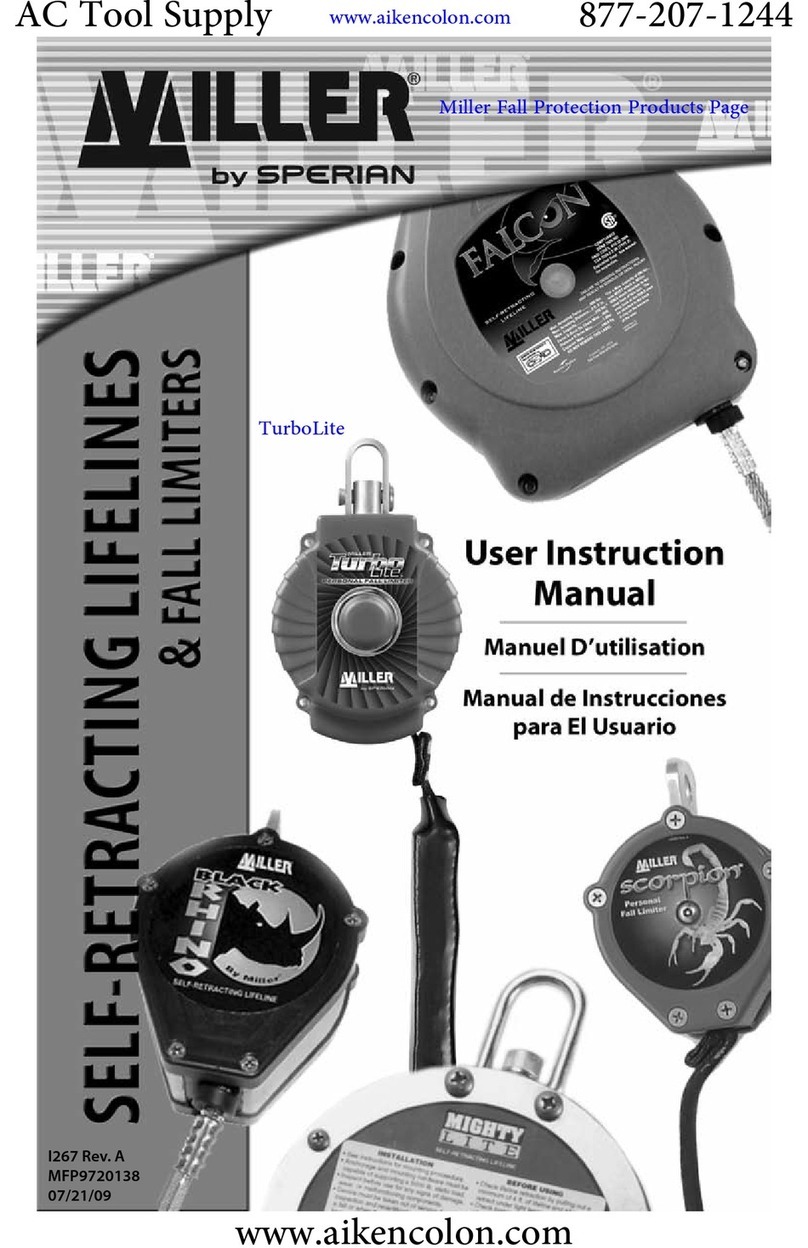
Sperian
Sperian Miller Scorpion User instruction manual
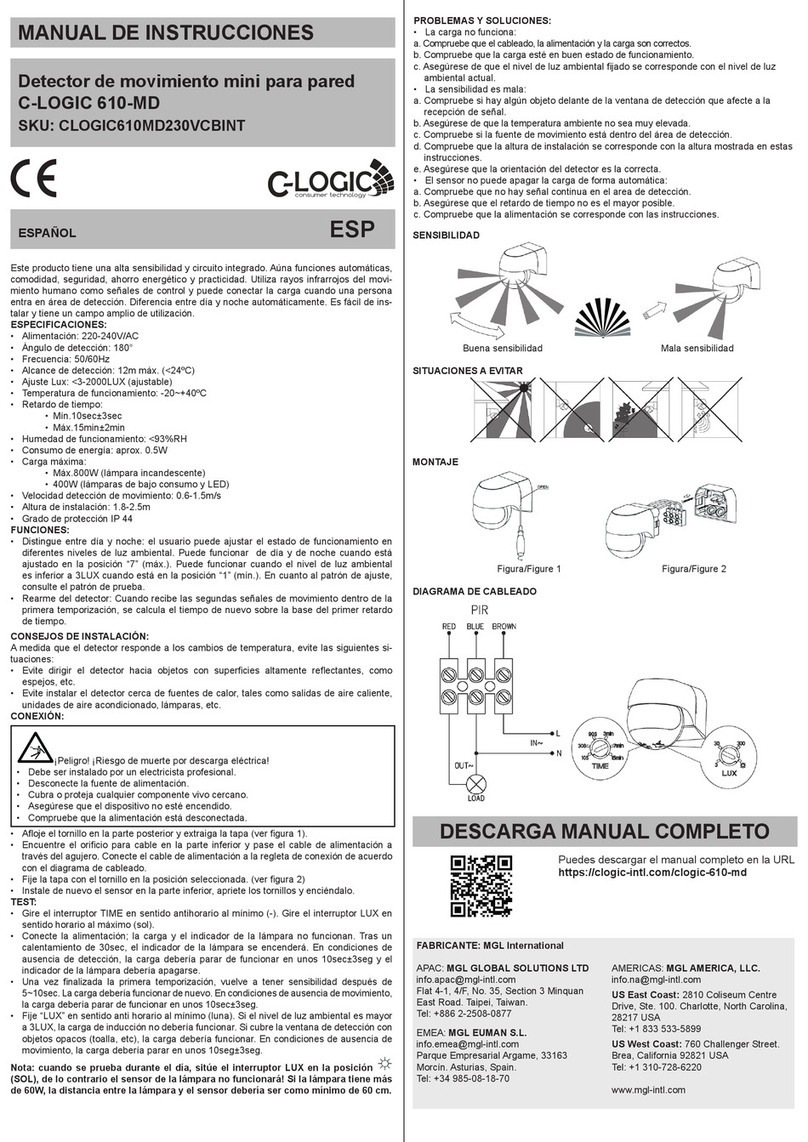
C-LOGIC
C-LOGIC 610-MD instruction manual
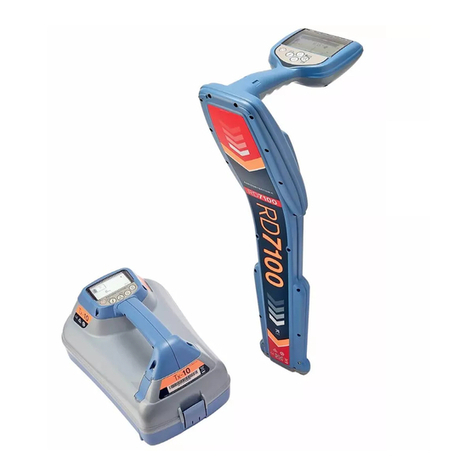
Radiodetection
Radiodetection RD7100 user guide
